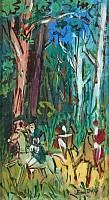BIOGRAPHY

Jean Dufy (French 1888-1964)
From a family of nine children, Jean Dufy was the younger brother of Raoul Dufy (1877-1953). The Dufy family was very open to the arts, particularly to music. From the age of 14, Jean exhibited artistic abilities that were encouraged by his brother Raoul, and Raoul’s friend A.E. Othon Friesz. Jean also painted theater sets. He enrolled in l’Ecole des Beaux-Arts du Havre, where he was taught by Raoul then by Friesz and Georges Braque.
Jean had, at this period of his life, discovered much from travels to North Africa and other European cities. World War I, during which he was a horse-soldier, interrupted his activities for a while. But by 1920, he began regularly exhibiting his paintings, notably at the Salon d’Automne, of which he was also a member. Along with his brother Raoul, Jean was active in the decorative arts, especially in textiles and porcelains.
Inevitably, Jean Dufy’s work continues to be compared to that of his brother. However, Raoul Dufy often dissected each of the elements that he used in his compositions, lending to his work acuteness. Jean, on the other hand, was more sensitive to the entire panorama of the scene represented—the complete atmosphere of his subject can be felt in his grand swathes of color and cohesive palette.
Jean painted frequently in oil, gouache, watercolor and ink. Like his brother, his subjects are often Paris, French leisure destinations, country scenes, circuses, horse races, stages and orchestras. He played the classical guitar and was an amateur of jazz, which may account for his paintings exhibiting a more fluid rhythm revealed in the deep blues, animated reds and greens, and yellows that tend to accentuate light. Towards the end of his career, Jean retired to his farm in the Loire River valley where he remained up until his death, continuing to paint the fresh, simple subjects, which were the love of his life.
